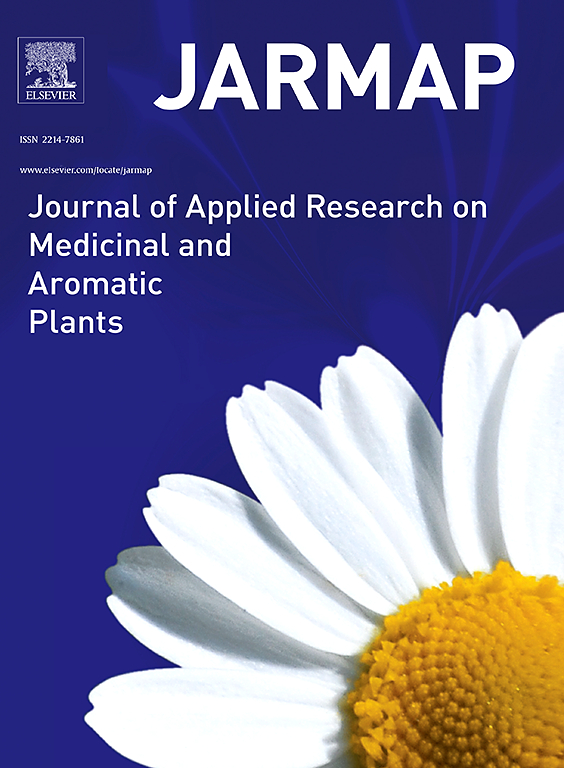西北喜马拉雅药用植物堇菜遗传多样性和种群结构的研究
IF 3.6
2区 农林科学
Q1 PLANT SCIENCES
Journal of Applied Research on Medicinal and Aromatic Plants
Pub Date : 2025-09-01
DOI:10.1016/j.jarmap.2025.100657
引用次数: 0
摘要
堇菜(Viola canescens)是堇菜科的重要药用植物。本研究利用SSR (cross-transfer simple sequence repeat,交叉转移简单序列重复)标记对96份甘蔗(V. canescens)的遗传多样性进行了分析。这些加入代表了查谟和克什米尔,北阿坎德邦和喜马偕尔邦的不同地点。17个SSR引物共检测到99个等位基因,平均5.82个。引物SLM6-3、SLM6-4、SLM6-7和SLM6-10检测到的等位基因数量最多(8个),引物WMC149-6D、TGSSR-7和BUMS-30检测到的等位基因数量最少(3个)。PIC值为0.466 ~ 0.810,平均值为0.672。引物BUMS-34的杂合度最高,为0.906,引物GPW4372-6D的杂合度最低,为0.396,平均值为0.702。引物SLM6-7的期望杂合度最高(0.834),引物GPW4372-6D的期望杂合度最低(0.499),平均值为0.718。同样,引物SLM6-7(6.48)和bams -30(1.791)分别显示出最大和最低的标记指数值。分子变异分析(AMOVA)显示群体间变异26% %,群体内变异74% %。树突图将所有材料分为三组。PCoA分析也显示了三个与树状图对应的组。利用贝叶斯聚类对结构进行分析,得到三个聚类。总体而言,利用交叉转移SSR标记获得的这些初步结果表明,甘蔗种质资源具有较高的遗传多样性水平。本研究结果为利用不同品种的甘蔗选育提供了有价值的基础。此外,检测到的不同种质可以作为保护策略的目标,以支持这种重要药用植物的可持续栽培和遗传改良。本文章由计算机程序翻译,如有差异,请以英文原文为准。
Elucidation of genetic diversity and population structure in medicinal plant Viola canescens from North Western Himalayas
Viola canescens is an important medicinal herb that belongs to family Violaceae. In the current study cross-transferred simple sequence repeat (SSR) markers were employed to examine the genetic diversity of 96 accessions of V. canescens. These accessions represented various locations of Jammu & Kashmir, Uttarakhand, and Himachal Pradesh. Overall 99 alleles with an average of 5.82 alleles were observed using 17 SSR primers. Four primers, namely, SLM6–3, SLM6–4, SLM6–7, and SLM6–10 detected the maximum number (8) of alleles, while the lowest numbers (3) of alleles were observed by three primers, WMC149–6D, TGSSR-7, and BUMS-30. PIC values ranged from 0.466 to 0.810 with a mean value 0.672. The maximum observed heterozygosity (0.906) was recorded in primer BUMS-34, while lowermost (0.396) was obtained by primer GPW4372–6D, with a mean value 0.702. Whereas, the maximum (0.834) expected heterozygosity was recorded in primer SLM6–7 and lowest (0.499) in primer GPW4372–6D, with a mean value of 0.718. Similarly, primers SLM6–7 (6.48) and BUMS-30 (1.791) have shown the greatest and lowest marker index values, respectively. Analysis of molecular variance (AMOVA) showed 26 % variance among the population and 74 % within the populations. Dendrogram divided all accessions into three groups. PCoA analyses also showed three groups in correspondence to dendrogram. Three clusters were obtained from the STRUCTURE analysis using Bayesian clustering. Overall, these preliminary results obtained using cross-transferred SSR markers indicates higher level of genetic diversity in V. canescens accessions. The insights gained from this study provide a valuable foundation for breeding programs by utilizing diverse accessions of V. canescens. Furthermore, the detected diverse accessions can be targeted for conservation strategies to support the sustainable cultivation and genetic improvement of this important medicinal plant.
求助全文
通过发布文献求助,成功后即可免费获取论文全文。
去求助
来源期刊

Journal of Applied Research on Medicinal and Aromatic Plants
Pharmacology, Toxicology and Pharmaceutics-Drug Discovery
CiteScore
6.40
自引率
7.70%
发文量
80
审稿时长
41 days
期刊介绍:
JARMAP is a peer reviewed and multidisciplinary communication platform, covering all aspects of the raw material supply chain of medicinal and aromatic plants. JARMAP aims to improve production of tailor made commodities by addressing the various requirements of manufacturers of herbal medicines, herbal teas, seasoning herbs, food and feed supplements and cosmetics. JARMAP covers research on genetic resources, breeding, wild-collection, domestication, propagation, cultivation, phytopathology and plant protection, mechanization, conservation, processing, quality assurance, analytics and economics. JARMAP publishes reviews, original research articles and short communications related to research.
 求助内容:
求助内容: 应助结果提醒方式:
应助结果提醒方式:


